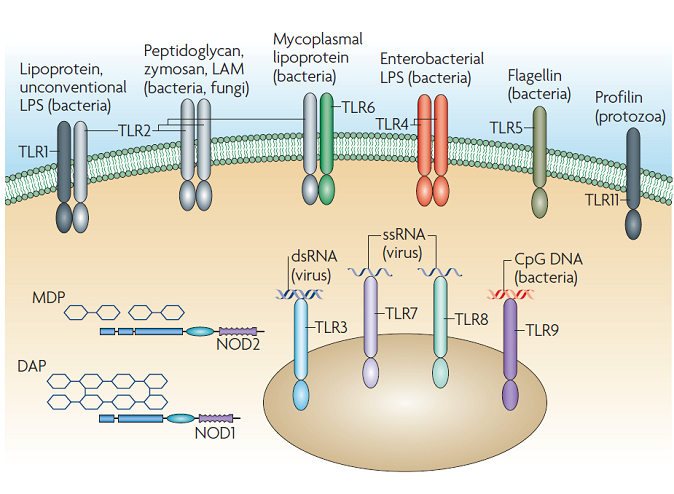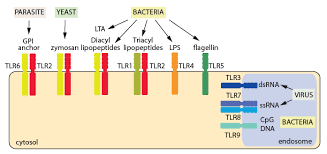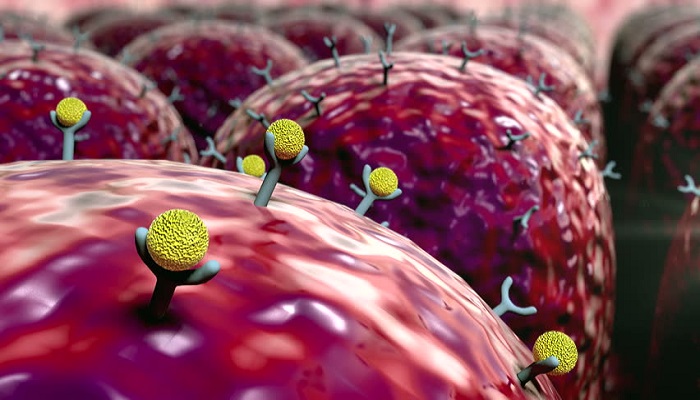Introduction
Receptors for innate immune system are specialized proteins that recognize foreign particles and the pathogenic bacteria. Consequently, the innate immune system generate specific responses in response to these receptor proteins, either itself or by activating the cells of adaptive immune system.
The innate immune system of body comprises of certain type of cells and proteins that defend the body against pathogenic infections and toxins. The response generated by innate immune system is immediate and not as long lasting as that of adaptive immune system.
Mast cells, phagocytes, neutrophils, macrophages, dendritic cells as well as innate lymphoid cells are part of innate immune system. Moreover, these cells and the receptors of innate immune system are specific for the type of foreign particle or the pathogen which they recognize.
All of the receptors detect or sense the type of inflammatory patterns of body that occurs in case of infection by pathogens. So these receptors of innate immune system are also termed as Pattern Recognition Receptors PRR’s. As they belong to innate immune system so can be termed as the Primitive Pattern Recognition Receptors of innate immune system berceuse the innate immune system was the very first defense system of organisms including humans.
Recognition patterns of receptors of innate immune system
These recognition patterns of host body are of two types:
1. Pathogen associated molecular patterns / PAMP’s
The small molecular structures or motif that are present in body of pathogen and shared by certain class of pathogens generate innate immune response when recognized by the receptor proteins. These structures are foreign particles to the host body. So they are recognized by receptors of immune system. PAMP’s generate the infectious inflammatory response in host body to kill the pathogens and remove toxins.
2. Damage associated molecular pattern / DAMP’s
Also termed as danger signal, these DAMP’s are results of toxins that are produced due to cell damage in body. They initiate or generate inflammatory but non infectious responses.
Types of pattern recognition receptors
These receptors of innate immune system are of four major types:
- Membrane Bound/ Cell Surface Receptors
- Cytoplasmic Recptors Or PRR’s
- Secreted Molecules Of PRR’s
- Phagocytic Receptors

Location of different receptors of innate immune system in cell
1. MEMBRANE BOUND PATTERN RECOGNITION RECEPTORS
This category further consists of these classes:
- Toll like receptors
- C-type lectin receptors
- Receptor kinases
1. TOLL like receptors (TLRs)
The very first Pattern Recognition Receptors to be discovered were these toll-like receptors. These are transmembrane proteins having a cytoplasmic along with an extracellular leucin-rich domain. They recognize large number of pathogen associated molecular patterns of certain bacteria, viruses and other pathogens. They also show some responses to some damage associated molecular patterns.
Cell wall of certain bacteria contains lipids in the form of lipopolysaccharides and lipoproteins that are recognized by these receptors and are removed from cells by phagocytosis. The number of TLR’s in mice is 11 while in human body they are 10 in number.
How TLR’s work?
Each type of TLR recognizes specific pathogen or the PAMP’s. When it recognizes the pathogen, TLR initiates or activates a cell signaling pathway that is mediated by the specified Cytokines proteins to generate a response to eliminate the foreign particles.
Pro-inflammatory Cytokines: these are produced before the inflammation response of innate immune system. Examples include IL-12 and IL-6.
Anti-Inflammatory Cytokines: these are produced to reduce the inflammatory responses. Their example is Interleukin-10.
Basically, the interactions of TLR and pathogen start a signaling pathway of cells that activates a transcription factor NF-Kb. This transcription factor activates cytokine genes that produce cytokins to generate inflammatory responses in human body. These genes can be different depending upon the type of pathogens. For example, the genes for tumor necrosis factors and the genes for chemokins etc.
These molecules modulate the response of Toll Like Receptors:
- Chemokines
- Cytokines
- Interferon (IFN)
- Co-Stimulatory Molecules
TOLL-like receptor 1 (TLR I)
Formation of heterodimer (dimer of two different molecules) with TLR II on the surface of cells enables them to attach to the gram positive bacterial strain that contains peptidoglycan in their cell wall. For example, staphylococcus bacterial is gram positive.
TLR II
Attaches to TLR I and helps in binding of cell with the cell wall of gram positive bacteria.
TLR III
Endosome is formed when the cell membrane surrounds the pathogen and invegenate inward to engulf it by process of endocytosis. These TLR bind to RNA of the viruses that are present in cell as endosome. But only for those viruses that have double stranded RNA as their genetic material.
TLR IV
They recognize gram negative bacterial strain due to presence of lipopolysaccharides in their cell wall. The gram negative bacteria are E.coli and Salmonella etc.
TLR V
They recognize motile bacteria due to the flagellin protein that is basic component of their flagella.

Recognition of microbial components by different types of Toll Like Receptors
TLR VI
Involved in formation of heterodimer with TLR II and help to recognize the peptidoglycan of the bacterial cells.
TLR VII & TLR VIII
Both of them form a dimer that recognizes certain single-stranded RNA containing viruses like influenza virus by binding to their single stranded RNA. These viruses are actually trapped in cells in the form of endosomes.
TLR IX
The cytosine base of the DNA of bacterial cell is usually methylated that it contains additional methyl group in it. In some cases, these receptors recognize methylated bases in genome of microbes.
The DNA of certain bacteria contains higher %age of guanine base than the cytosine base. This is termed as CpG that shows the higher %age of guanine than cytosine as well as “P” describes the presence of phosphodiester bond between these bases. These CpG regions are also the site of recognition of microbes by these receptors.
TLR XI
This toll-like receptor is not present in humans but in mice only. This TLR binds specified proteins of infectious particles. For example, the flagellin protein.
In response to these TLRs, certain inflammatory responses are generated in body by the innate immune system and it can lead to activation of adaptive immune system as well.
2. C-TYPE lectin receptors (CLR)
These receptors have a carbohydrate- recognition domain. They recognize the foreign particles by binding to carbohydrate components of their cell membrane and their binding is calcium dependent. The examples of C-type lectin receptors are mincle, DC-SIGN, dectin- 1 receptors. They mainly recognize the fungal particles and modulate the innate immune system.
In fungal and bacterial cells, these receptors recognize the mannose component of their cell walls. Fucose of helminthes and glucan component of certain mycobacteria are recognized by them.
This family of receptors contains one lectin domain in their stricture that is specified for carbohydrate recognition. This domain is a ligand binding motif that requires Ca2++ ions when they bind to sugar particles. On the other hand some of the receptors don’t have the ability to bind to sugars although they are structurally C-type or lectin containing receptors.
The type of modulation they made to innate immune system is either endosytic or some cell signaling pathway that entirely depends upon the type of pathogenic particle. For example, the cell signaling pathway includes NFkB or TLR activation by these C-type receptors.
These CLR’S have two categories:
CLR Mannose Receptors
Present on the surface of macrophages and certain dendritic cells these receptors recognize the mannose component of the cell wall of fungi.
CLR Asialoglycoprotein Receptors:
Their examples are DC-SIGN / CLEC4L and langerin /CLEC4K.
3. Receptor kinases
These receptors are exclusive for plants only and contain certain domains in their structure.
2. CYTOPLASMIC PATTERN RECOGNITION RECEPTORS
These receptors have further two types:
- NOD like Receptors
- RIG like receptors
1. NOD like receptors (NLR’S)
These receptors are named as NOD like receptors because of presence of nucleotide-binding oligomerization domain in their structure. This domain has the ability to bind to nucleoside triphosphate. They generate responses and interact with the specific microbial particles by their C-Terminal leucine-rich repeat and generate signals by their N-terminal domain to activate cytokines genes. In mammal’s body, 20 types of these receptors are found that are responsible for generating certain apoptotic and inflammatory responses. They recognize bacterial and other microbial particle and then produce oligomers that activates inflammatory caspases.
Caspases are proteolytic proteins which participate in cell signaling pathways of programmed cell death or apoptosis. The result is activation of certain cytokines such as NFkα and IL-1 etc.
Subclasses of NLR’S
Subclasses of this family are:
- NOD’S
- Inflammasomes
- NALP’S
- MHC II protein transactivator etc
NOD subclass
It has further types of NOD1 & NOD -2. Both of them recognize a peptidoglycan component, MESO-DAP of gram negative bacterial cell wall. Also they can recognize the intracellular muramyl dipeptide that is a constituent of the gram +ve and gram -ve bacteria.
They take part in the cell signaling pathway such as for activation of inflammatory NFkB and MAP Kinases.
NALP’S receptors
NALPS are pyrrin domain containing NLR having C-terminal leucin repeat region (LRRs) that acts as their regulatory domain. Similar to other NOD receptors, they bind to nucleoside triphosphate by nucleotide binding site. N-terminal pyrin domain controls their interaction s with other proteins.
In humans, there are 14 types of NALP from NALP1- NALP14. Mutation in any of these receptors can result in auto inflammatory diseases of immune system. For example, NALP-3 mutation results in familial cold auto inflammatory syndrome.
NALPS are activated in response to or they recognize the muraml dipeptide of microbial genome, certain toxins. Moreover some viruses that have double stranded RNA as their gentic material such as paramyxovirus activate these receptors. They can activate capases in response to ligionella bacterium to generate inflammatory response.
Infammasomes
Inflammasomes are a type of cytoplasmic protein complexes that belong to NOD like receptor family. They are involved in maturation of inflammatory cytokines such as interleukins IL-1α and IL-1β as they control activation of caspases of signaling pathways.
Their functioning is closely related to the NALPS receptors. Assembly or arrangements of these inflammasomes depends upon certain NALPS or other NOD like receptors. These infammasomes activation occurs in response to microbial particle in host body.
MHC class II proteins
Mainly present on antigen presenting cells such as monolayer phagocytes and the dendritic cells, B cells and T-cells, these protein complexes are important in generating innate immune response. The antigens to which they bind belong to some extracellular proteins such as those of microbial cells. Lysosomal enzymes endocytose and digest the extracellular proteins and cell later removes them. The main purpose of these MHC II proteins is to derive some signaling pathway to generate inflammatory response or the activation of cells of adapted immune system to combat the foreign particles.
2. RIG like receptors (RLR’S)
They belong to a cytoplasmic RNA helicase family of receptors that specifically recognize the double stranded RNA of the viral particles. They recognize them due to their pathogen associated molecular patterns (PAMP). These receptors have and RNA binding domain in their structure.

Diagrammatical representation of domains of RIG like Receptor and its activation by ssRNA
They activate a transcription factor of the genes. The gene product is interferons IFNs in these cells to initiate an antiviral response in body.
These RLR’s have further three types:
- RIG- 1 that stands for retinoic acid inducible gene 1.
- Melanoma differentiation associated factor-5 MDA-5
- LGP 2 (Its name is due to the laboratory genetics & physiology)
Expression or activation of any of these receptors results in signaling pathway to initiate innate immune response. They show their function in epithelial cells, cells of nervous system. The dendritic cells express them but these do not necessarily involve in IFN (interferon) production in these cells.
After they expose to some viral particle in cells, and when there is more production of interferon in cells, these receptors become more active in these situations.
3. SECRETED PATTERN RECOGNITION RECEPTORS
These receptors of innate immune system do not remain associated with cell from which they are produced.
Types of secreted receptors are:
1. Definsins
These proteins protect and line up all the surfaces of human body along with epithelial layer. In addition, these act as the receptors for innate immune system as well.
2. Ficolins
Circulating proteins C-proteins are also secreted receptors. These not only trigger the cell signaling pathway but also results in opsonization of pathogen. Opsonization is actually locating the microbial or foreign particle by certain receptors of innate immune system. The result of opsoniztion is quick phagocytic response of cells to remove or digest the pathogen particle by cells of innate immune system.
3. Mannose Binding Lectin
This is one of the major secreted types of receptor. It usually recognizes and attaches mannose sugar component of the cells microbial cells but also have the ability to bind to certain phospholipids, non glycosylated proteins. Once they recognize the foreign particle, they initiate lectin pathway of the innate immune system for its response.
Some other types are:
- Pentraxins
- Serum amyloid
- Collectins
- Lipid transferases
- Peptidoglycan recognition proteins
4. PHAGOCYTIC RECEPTORS
The macrophages cells are involved in digestion of pathogens by phagocytosis. They recognize the pathogen associated molecular patter such as those which contain mannose. Similarly certain pathogens are recognized by the type of polysaccharides that cover their cells. Therefore, the cells of innate immune system engulf the pathogens and form a phagosome. Later, lysosomal enzymes digest phagosome.
CD14 macrophages are this type of receptors that have leucin rich domain. Their ligands are terminal mannose sugar residue and their function is phagocytosis and also helps Toll like Receptors for trigging immune response.
Innate immunity can trigger adapted immune system
The response of innate immune system with the help of receptors can trigger the cells of adapted or the acquired immune system. This is basically to develop long lasting immune response as the response of innate immune system is for short duration.
The cells of adapted immune system such as B-cells and T-cells upon activation, start producing specific antibodies molecules. So the collaboration of innate and the adapted immune system results in removal of pathogens and toxins from the host body.


1 thought on “Receptors of immune system”
Comments are closed.